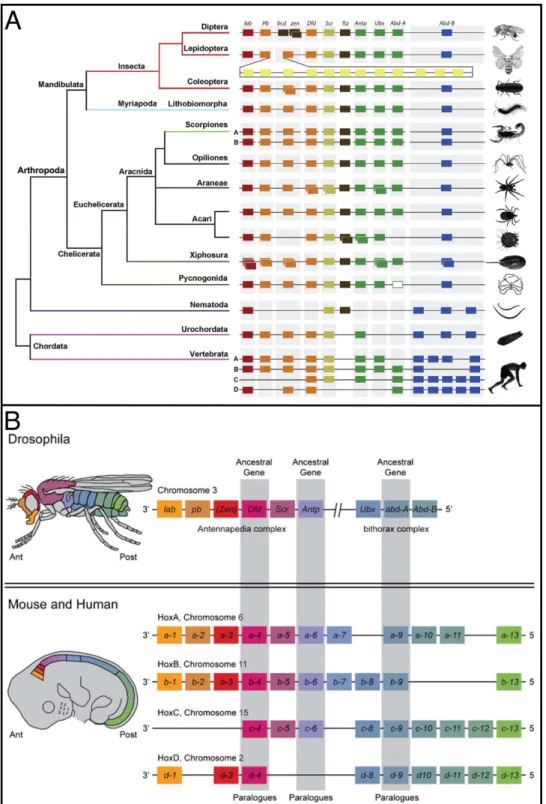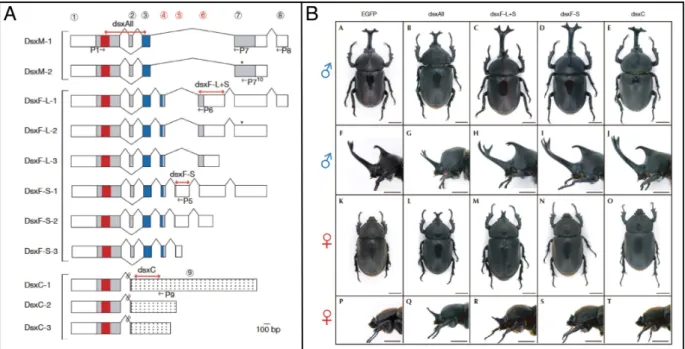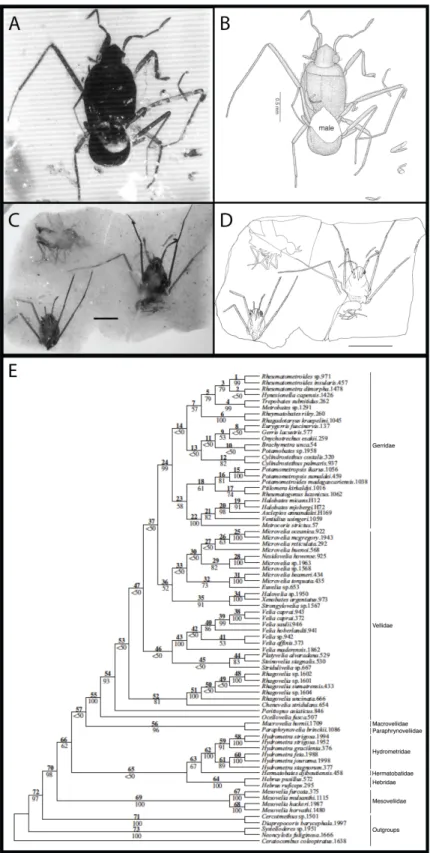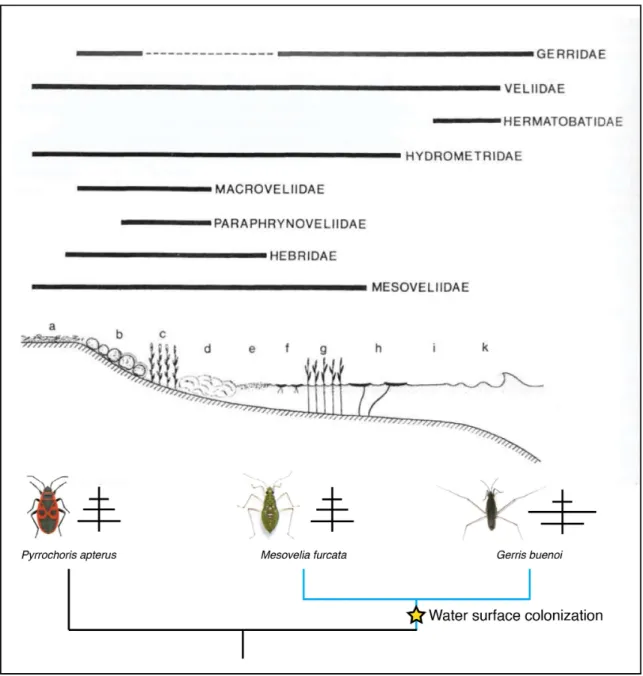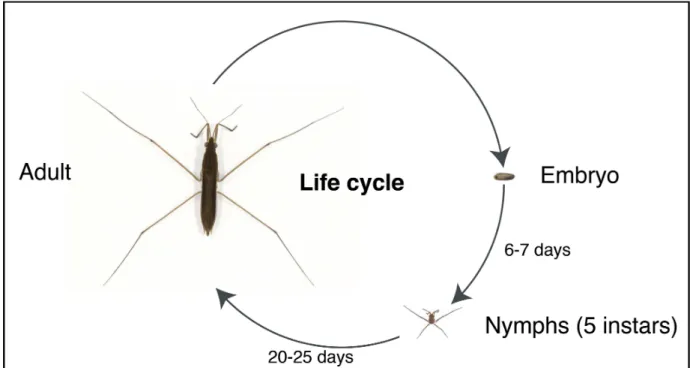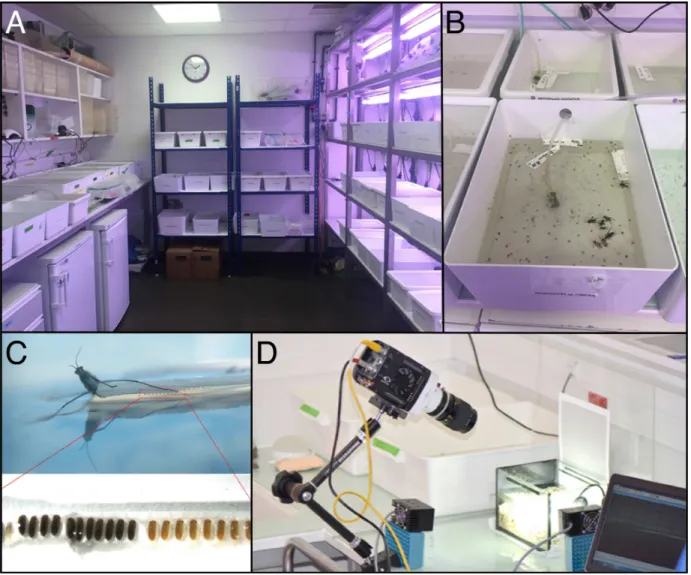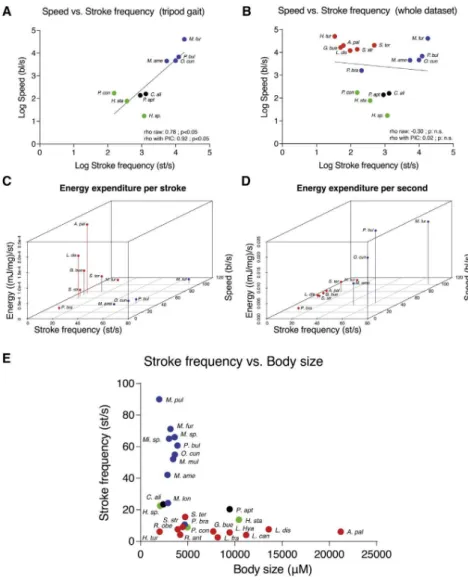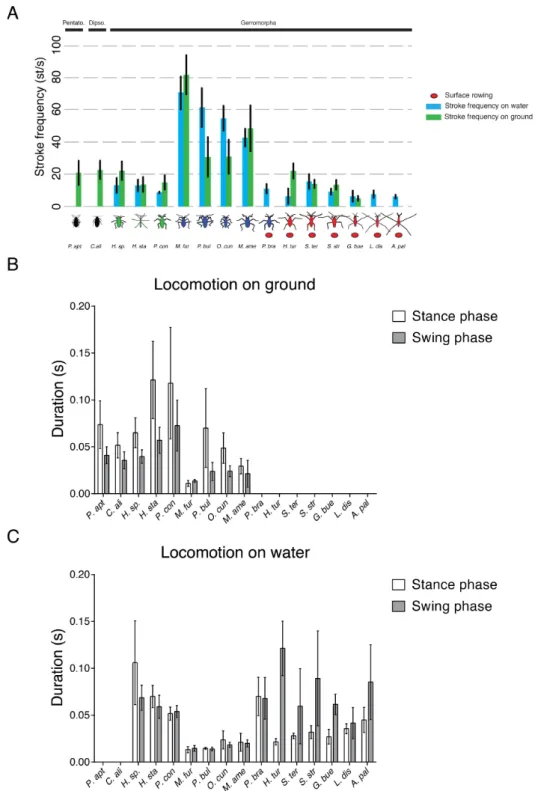HAL Id: tel-01689880
https://tel.archives-ouvertes.fr/tel-01689880
Submitted on 22 Jan 2018
HAL is a multi-disciplinary open access
archive for the deposit and dissemination of
sci-entific research documents, whether they are
pub-lished or not. The documents may come from
teaching and research institutions in France or
abroad, or from public or private research centers.
L’archive ouverte pluridisciplinaire HAL, est
destinée au dépôt et à la diffusion de documents
scientifiques de niveau recherche, publiés ou non,
émanant des établissements d’enseignement et de
recherche français ou étrangers, des laboratoires
publics ou privés.
Developmental mechanisms of adaptive phenotypes and
associated ecological relevance in the semiaquatic bugs
Antonin Crumière
To cite this version:
Antonin Crumière. Developmental mechanisms of adaptive phenotypes and associated ecological
rele-vance in the semiaquatic bugs. Symbiosis. Université de Lyon, 2017. English. �NNT : 2017LYSEN095�.
�tel-01689880�
Numéro National de Thèse:
2017LYSEN095
THESE de DOCTORAT DE L’UNIVERSITE DE LYON
opérée par
l’Ecole Normale Supérieure de Lyon
Ecole Doctorale N°340
Biologie Moléculaire, Intégrative et Cellulaire (BMIC)
Discipline: Biologie
Soutenue publiquement le 14 Décembre 2017, par:
Antonin CRUMIERE
Developmental mechanisms of adaptive phenotypes and associated
ecological relevance in the semiaquatic bugs
Mécanismes développementaux des phénotypes adaptatifs et
leur importance écologique chez les insectes semi-aquatiques
Devant le jury composé de:
Dr. Jessica Abbott – Group leader, Lund University, Rapporteur et Examinateur
Dr. Nicola Nadeau – Group leader, University of Sheffield, Rapporteur et Examinateur
Dr. Anthony Herrel – Directeur de Recherche, MNHNP, Rapporteur et Examinateur
Dr. Charlie Scutt – Directeur de Recherche, ENS de Lyon, Examinateur
2
3
Acknowledgments
As the tradition, let’s start this PhD thesis manuscript with acknowledgments.
This part will be probably the hardest to write for me just because I consider that words
are too weak to express what I really feel and also because I consider that acts are
more important than words.
I want first to thank my PhD committee, Dr. Christen Mirth and Pr. Laurent Viriot
who provided a lot of insight into my project. It was a pleasure to show you my
progression and to discuss during these four years. I also thank the member of my
jury, Dr. Nicola Nadeau, Dr. Jessica Abbott, Dr. Anthony Herrel and Dr. Charlie Scutt,
who agreed to evaluate this work.
I thank my parents and family. Since I was young at school you pushed me to
have good marks, not to be proud of me but just because “if you work well at school
you will be able to do a job that you like”. You also offered me the opportunity to open
my mind and you transmitted moral and social values that build who I am today.
Then I want to thank Dr. Chantal Diaz, who gave me the opportunity to do my
first research internship at the end of my Bachelor degree. At this time I was not really
a hard worker and my marks were passable. You asked me whether I wanted to do a
PhD. I said yes. You told me “you can, you are not stupid at all, but you are too lazy at
learning your courses and you will not succeed during your Master to be able to do a
PhD”. I think it was exactly what I needed to hear at this time. This internship was
more than helpful for me. I also want to thank Dr. Nathalie Depège-Fargeix, who was a
great supervisor during my second internship. Even if I moved to the IGFL afterward, I
absolutely do not regret my internship at the RDP.
Let’s move to the Khila lab. Thank a lot Abdou for these years! I have to say
that I am proud to have been part of the Khila lab. Since I started here I learned so
many things related either to science or to human being, and I feel now that I am well
prepared for my future. Of course we learn all along our life but it is really appreciable
to feel confident to face the next steps.
4
Séverine, David and Peter, the three first persons in the lab when I started. I
remember Séverine, you were happy to see a new person coming in the lab like a
family that grows up. Actually I also remember my first morning as trainee when,
David, you entered in the office, you growled an “hello” and then you sited in front of
your screen in the “matrix” without speaking. I though that discussing with you would
be a pain J. Peter, I remember this day where we started to inject bugs at 7pm on
Friday, you were not complaining while I was simmering to go home.
Then come William “copain” and Emilia... my two companions in misery to
control Abdou drives during fieldwork in French Guiana. I am sure you know what I
mean J. Discussion about science are always long with William, you are too
passionate for me J. Emilia I was really happy to work with you on projects, I learned
a lot and we were kind a complementary to hold motivation.
Amélie and Augustin, I remember when you arrived Amélie, it was a pain to
explain to you that a protocol is a kind of recipe that you can modify. Things have
changed a lot! Augustin, the man from the moon living in the sky with who we can
have such as stratospheric discussion about interesting or stupid things.
Aïda, Aïda, Aïda! We met the first time in Panama when I was doing fieldwork
and when you just learned that you were going to join our lab. I really hope you will be
successful after you PhD when you will be back in Panama. François, there is one
important thing that I clearly learned or at least realized from you during these years:
words have a meaning and use them well means transmit exactly the message we
want to transmit. Thank you because this is something useful not only in science.
Cédric, Antoine and Roberto, my climbing brothers. What a pleasure to climb
some walls (at least to try) with friends after a day of work. Antoine, I hope you will
enjoy research in South Africa. Cedric, I am sure you will live in Asia at some point or
maybe for the rest of your life J. Roberto, you just arrived in the lab but we met at
several occasions before. Thanks a lot for your help for my postdoc fellowship
application. I hope you will enjoy working with water striders.
5
Marie and Mathilde, it is a pleasure to see you working at the bench. You seem
really enjoying to learn new things and I think it reminds me when I started in the lab. I
do not forget Pauline and her cakes J. I also thank the different students that
performed internships in the Khila lab during these years. I want also thank the IGFL
members, especially the administrative staff, who was more than nice and efficient
with orders, documents and travel organization.
I want also thank Princeton folks. Thanks Sarah for this opportunity of research
stay in the Kocher lab at Princeton. Thanks to Ben, Eli, Paul, Luisa, Serge, Diego,
Micah, Sudarshan, Alicia, and Julien. These three months, like a pre-postdoc, were
determinant for my motivation during the last year of my PhD. I really hope to come
back soon.
I want to thank you, Ludivine, for your support. I hope I was not too tiresome
during these months of redaction (especially at the end).
Finally, I would like to acknowledge you, my friends who unconsciously have
supported me during these years: Quentin (Gros), Kelly (Momo), Arnaud (Arnold),
Marion (Poujlove), Gilles (Guilles), Leslie (Leslove), Maxime (Mox), Sylvain (Mousse),
Cyril (Lep), Paul (Paulo), Benjamin (Benj), Marine (Patchone), Giovanni (Giovannoi),
Pierre (Racaillou), Théo (Chef Nounou), Benoit (Ben), Nathan (Johnny), Alexandra
(Barbie), and all persons I could have forgot. We shared so many precious moments
digging holes in the cold, playing badminton, hiking in the snow, escaping zombies or
sharing meals with drinks. Thanks a lot!
6
Developmental mechanisms of adaptive phenotypes and underlying
ecological relevance in the semiaquatic bugs
How diversity arises is a major question in evolutionary biology. Since Darwin’s
expeditions during the 19
thcenturies and “The Origin of species” (Darwin, 1859) it is
now widely accepted that any given organisms face a variety of ecological pressures
along its lifespan. Genes, alleles and phenotypes that increase fitness are favored by
natural selection and are transmitted to the next generation. Natural and sexual
selection are intrinsically linked and explain why phenotypes are maintained while the
genotype explains how phenotypes are formed (Figure 1). These processes directly
impact the diversification of species and ultimately generate diversity.
The origin of diversity can be studied in different ways at different levels and
timescales. We can study the diversity of species, morphologies, behaviors,
physiologies, developmental processes, or molecules using different approaches such
as evolution, development, and ecology across extinct and extant species (Figure 1).
In the presented thesis I combined these three fields to understand the complexity of
the relations between the different components of natural selection, namely
survivorship, mating success and fecundity; with the genotype and their impact on the
evolution of organism phenotypes (Figure 1). I used the Gerromorpha, also known as
the semiaquatic bugs, a group of insects that transited from terrestrial life to life on
water surface habitat and associated sub niches. In addition to their evolutionary
trajectory, these insects have a large diversity of morphologies, behaviors and habitats
and are easy to breed in laboratory condition, which make them powerful systems for
Eco-Evo-Devo studies. Along the five chapters of this thesis, I will develop several
examples that increase our understanding about how ecological pressures act on
phenotype evolution and how genes participate to the development of adaptive traits.
7
Figure 1: Representation of the concepts and fields used throughout this PhD
work. The combination of Development, Evolution and Ecology fields allows us
to understand how the relationships between the genotype and the selective
pressures shape the phenotype and ultimately phenotypic diversity.
8
List of abbreviations
dsRNA: double stranded RNA
dsx: doublesex
Hox gene: Homeotic gene
RNAi: RNA interference
Scr: Sex combs reduced
T2: thoracic segment 2
T3: thoracic segment 3
Ubx: Ultrabithorax
9
List of figures
Figure 1: Representation of the concepts and fields used in the presented thesis. .... 7
Figure 2: Examples of adaptive traits. ... 14
Figure 3: Sexual conflict and antagonistic coevolution. ...16
Figure 4: Evolution of the Hox cluster. ...18
Figure 5: The sex determination gene doublesex involved in sexual dimorphism. .... 20
Figure 6: Fossils and phylogeny of the semiaquatic bugs. ...22
Figure 7: Habitat, morphology and locomotion of the semiaquatic bugs. ...24
Figure 8: Example of life cycle in the semiaquatic bugs (Limnoporus dissortis). ...26
Figure 9: Animal rearing facility. ...28
10
Table of contents
General introduction and literature review ... 11
I. Ecological pressures, fitness and adaptive phenotypes ... 12
1.1 Selective pressures and survivorship ... 12
1.2 Examples of adaptive traits and their impacts on evolution ... 12
II. Sexual interactions, fitness and sexual dimorphism ... 15
2.1 Sexual conflict ... 15
2.2 Antagonistic coevolution and arms race ... 15
III. Genetic basis of morphological evolution ... 17
3.1 Molecular genetic mechanisms ... 17
3.2 Examples of genes involved in morphological diversity ... 17
IV. The semiaquatic bugs as model systems ... 21
4.1 Evolution of semiaquatic bugs ... 21
4.1.1 Fossil record and phylogeny of the semiaquatic bugs ... 21
4.1.2 Transition from land to water ... 23
4.1.3 Leg morphology and locomotion on water ... 23
4.1.4 Sexual interactions ... 25
4.2 Semiaquatic bugs as laboratory models ... 25
4.2.1 Semiaquatic bug life cycle ... 26
4.2.2 Laboratory population rearing ... 27
4.2.3 Experimental advantages ... 29
4.2.3.1 Genomic, transcriptomic and phylogenetic analysis ... 29
4.2.3.2 Gene expression analysis ... 29
4.2.3.3 Gene function analysis ... 30
4.2.3.4 Trait function analysis ... 30
Objectives of the presented thesis ... 31
Chapter 1 ... 33
Diversity in morphology and locomotory behavior is associated with niche
expansion in the semiaquatic bugs. ... 33
Chapter 2 ... 59
Emergence of tissue sensitivity to Hox protein levels underlies the evolution of
an adaptive morphological trait. ... 59
Chapter 3 ... 91
Predator strike shapes antipredator phenotype through new genetic interactions
in water striders. ... 91
Chapter 4 ... 111
Taxon-restricted genes at the origin of a novel trait allowing access to a new
environment. ... 111
Chapter 5 ... 161
Dimorphism under sexual conflict controlled by the combination of sex
determination and Hox genes. ... 161
General discussion ... 181
11
12
I. Ecological pressures, fitness and adaptive phenotypes
1.1 Selective pressures and survivorship
The ecological pressures of the habitat where species live directly challenge every
organism, and by impacting the different components of fitness, select for the most
adapted individuals. These environmental selective pressures include physical
environmental factors (temperature, pressure, water current velocity, pH, mineral
composition of the niche), types of food resources and availability, predator-prey
interactions, density of population, and competition with other members (Chase and
Leibold, 2003; Ghalambor et al, 2003). These diverse interactions result in pressures
on species that select individuals with best-adapted phenotypes and underlying
genotypes. Adaptive phenotypes increase the overall fitness of organisms under
specific environmental conditions (Orr 2005a, Orr 2005b). Organisms that live longer
generate more offspring, and therefore transmit genes involved in the development of
selected adaptive traits to the next generations. The differences in selective pressures
and genetic contents between organisms have a central role in generating the diversity
of phenotypes observed in nature.
1.2 Examples of adaptive traits and their impacts on evolution
Adaptive phenotypes are quite diverse in nature and can have different
magnitudes of impact by increasing the fitness of organisms in their habitat or by
changing the evolutionary trajectory of a complete group of organisms through
diversification (Schluter 2000; Losos 2009). In the first case, adaptive phenotypes
increase the fitness of organisms without affecting the rate of species diversification.
Some historical adaptive phenotypes are well known in the literature such as the dark
coloration affecting moths and other insects following the industrial revolution
(Kettlewell 1955; Lees & Creed 1975). The coloration directly impacts survival when
the insect matches the color of the tree background thereby avoiding detection and
predation by birds. A second example is the different morphologies of armor and
spines in the three-spine sticklebacks (Barrett et al, 2008; Bell et al, 1993; Klepaker
13
1993) (Figure 2A) associated with the presence of predators and the calcium
concentration of the water where sticklebacks live. A third example is the mimicry in
Heliconius butterflies used to mimic toxic preys and intimidate predators (Walbank et
al, 2016) (Figure 2B).
While they are spectacular, the three examples cited above have not impacted the
evolutionary history of their respective groups as strongly as key innovations did. Key
innovations represent a particular case of adaptive traits that had a huge impact on the
diversification and evolution of a group of organisms (Schluter 2000). A key innovation
is an adaptive phenotype that provides access to unexploited resources and that
allowed a rapid burst of species diversification due to a release in selective pressures
(Schluter 2000; Losos 2009). Examples include:
-
The pharyngeal jaw of the cichlids fishes from the great African lakes that
allow them to exploit the different types of resources (from plankton to
snails) present in their respective sub niches (Muschik et al, 2012).
-
The beak of birds with the historical example of the Darwin finches that
use their beaks to exploit the different types of seeds present in the
Galapagos Islands (Figure 2C) (Grant & Grant 2008 and 2014).
-
The flower of plants that attracts insects or birds, which contribute to
disseminate the pollen, and therefore increase the mix of gametes
(Figure 2D) (Albert et al, 2002).
-
Insect wings that open new unexploited resources for the groups and
allowed escaping predators, dispersal and foraging behaviors (Averof &
Cohen, 1997).
-
Toepads and limb length of anoles lizards that allow the different species
to exploit different sub niches in the forest of the Caribbean Islands
(Losos 2009).
14
While a large number of phenotypes are considered as adaptive due to their
association with specific evolutionary success, the adaptive value is difficult to
evaluate but remains fundamental to understand how environmental factors select for
specific phenotypes and how these phenotypes allow their bearer to face ecological
pressures.
Figure 2: Examples of adaptive traits.
(A) the armor plates and spines in three-spine sticklebacks (from Barrett et al, 2008), (B) the
mimicry of Heliconius butterflies (from Walbank et al, 2016), (C) The beak of Darwin finches
(from Grant & Grant, 2014), (D) the flower of flowering plants (from Chamberdali et al, 2016).
15
II. Sexual interactions, fitness and sexual dimorphism
Sexual selection is part of natural selection and defines mating success, i.e. the
ability to secure mating partners. Sexual selection operates via three different
processes, namely male-male competition, mate choice and sexual conflict
(Andersson 1994; Arnqvist & Rowe, 2005). These three processes contribute to
generate diversity by driving sexual dimorphism; however, in the presented thesis I will
only focus on sexual conflict.
2.1 Sexual conflict
Under sexual conflict, males and females have opposite benefits and costs in
terms of mating rate. Females have a limited number of eggs and are favored by
selection to mate less frequently than males. Additional superfluous matings are
known to be unnecessary and even costly by exposing females to predation, injuries
or infections (Figure 3A) (Arnqvist & Rowe, 2005). For males the situation is different.
Even after mating, males are not sure to fertilize eggs due to sperm competition.
Therefore males with high mating rate are favored by selection because they benefit to
mate as much as possible with the maximum number of partners to sire the highest
number of offspring possible (Figure 3A). This opposition in benefits and costs
between males and females is the source of sexual conflict (Arnqvist & Rowe, 2005).
2.2 Antagonistic coevolution and arms race
Sexual conflict can drive the coevolution of antagonistic behavioral,
morphological or physiological traits between males and females through interlocus
conflict (Arnqvist & Rowe, 2005). If a trait appears in one sex, in response the second
sex can also develop traits to counter the first adaptation. This process of antagonistic
coevolution can lead to escalation and arms race (
Dawkins & Krebs, 1979;
Arnqvist &
Rowe, 1995; Weigensberg and Fairbairn, 1996). Examples of traits that have evolved
under sexual conflicts include the coevolution of the genitalia in ducks (Brennan et al,
2009; Brennan & Prum, 2015) and spiders (Kuntner et al, 2009 and 2016), the male
intromittent organ and female paragenitalia structure in
traumatically
inseminating
16
bugs (Tatarnic and Cassis, 2010, Morrow et al, 2003; Reihart et al, 2003), the harming
penis and resistance of female genitalia in beetles (Gay et al, 2011), male and female
plugs (Kuntner et al, 2012), male sex-peptide and female microRNA resistance in
Drosophila (Wigby et al, 2005; Fricke et al, 2014), antennae and the abdominal shape
of semiaquatic bugs (Khila et al, 2012; Arnqvist & Rowe, 2002), male adhesive discs
and the modification of female dorsal part in diving beetles (Bergsten et al, 2001;
Bergsten & Miller, 2007). Sexual conflict therefore highly contributes to sexual
dimorphism and represents an important source of morphological diversity. While arms
races also exist in the context of predator-prey interaction, in the presented thesis I will
only focus on sexual arms race and its impact on morphological diversity.
Figure 3: Sexual conflict and antagonistic coevolution.
(A) Schematic representation of the differences in fitness and mating rate between males and females
at the origin of sexual conflict. (B) Modification of male antennae in Rheumatobates rileyi that increases
mating success during pre-mating struggles (modified from Khila et al, 2012). (C) Modification of
abdomen shape in Gerris with a spike in female abdomen to increase distance between male and
female genitalia and counter adaptation in the male with curved abdomen allowing the male to avoid the
spike (from Arnqvist & Rowe, 2002).
17
III. Genetic basis of morphological evolution
The phenotype of each individual is shaped during development and is determined
by the combination of developmental genetic mechanisms and the action of hormones
and metabolic pathways (Hughes & Kaufman, 2002; Jindra et al, 2015; Casasa et al,
2017). However in the presented thesis I will only focus on developmental genetic
mechanisms.
3.1 Molecular genetic mechanisms
The genome of each individual and its expression during development contribute
to shape the morphology of an organism. Genes can be lost (Albalat & Cañestro,
2016) or emerge de novo and acquire new function (Rastogi & Liberles, 2005). DNA
variants resulting from mutations, gene isoforms resulting from alternative splicing, and
epigenetics can influence gene activities or protein interactions and therefore change
the pattern and the level of gene expression or create new genetic interactions
involved in the evolution of traits (Sniegowski et al, 2000; Andreadis et al, 1987; True
& Carroll, 2002).
3.2 Examples of genes involved in morphological diversity
Certain genes have a large impact on the development of organisms and highly
influence the phenotype of species. This is the case of the Homeobox genes (Hox
genes). These genes are organized in a cluster in the genome (Figure 4) and code for
transcription factors characterized by the presence of the homeobox domain
(homeodomain), a DNA binding domain conserved among the homeobox containing
genes (Garcia-Fernandez 2005; Gehring 1985; McGinnis et al, 1984; Scott & Weiner,
1984). They regulate the expression of a high number of downstream targets
(Pavlopoulos & Akam, 2011) through interaction with a variety of diverse co-factors
(Merabet & Hudry, 2012). Hox genes are involved in establishing the identity of
segments along the body axis during embryogenesis in a number of lineages
(McGinnis & Krumlauf, 1992; Hughes & Kaufman, 2002; Angelini et al, 2005) and are
involved in late development until adulthood (Chesebro et al, 2009). They are highly
18
conserved between vertebrates and invertebrates and the evolution of the cluster has
contributed to the diversification of morphology (Figure 4) (Hughes & Kaufman, 2002;
Akam et al, 1994; Averof & Akam 1993; Averof & Akam 1995; Krumlauf 1994;
McGinnis et al, 1984; McGinnis & Krumlauf 1992; Scott & Weiner 1984; Pearson et al
2005; Garcia-Fernandez 2005). In addition to their roles in segment identity, the Hox
genes are also involved in the fine tuning of specific structures such as the sex combs
(Tanaka et al, 2011; Chesebro et al, 2009), the abdomen pigmentation (Kopp et al,
2000), the genitalia (Glassford et al, 2015), the eye spot in butterfly (Shirai et al, 2012),
the halters in Drosophila (Hersh et al, 2007) and the leg length in crickets and
semiaquatic bugs (Mahfooz et al, 2007; Khila et al, 2009).
Contrary to Hox genes that are highly central during development, other genes
have more subtle effects, which generally allow a fine-tuning of the phenotype. These
genes have been found to include transcription factors, enzymes, signaling proteins or
transmembrane proteins. Examples include the level and pattern of expression of the
transcription factor Alx3 and the transmembrane receptor Agouti in rodent color
pattern involved in camouflage (Manceau et al, 2011; Mallarino et al, 2016), the level
of expression of the receptor BMP4 in the diversification of beaks in Darwin finches
(Abzhanov et al, 2004), the glycoprotein Wnt in the development of wings and halters
in Drosophila (Sharma & Chopra, 1975) and the transcription factor Distal-less in the
antennae of some water strider species (Khila et al, 2012) and wing spots in
Drosophila (Arnoult et al, 2013) and butterflies species (Shirai et al, 2012).
19
Figure 4: Evolution of the Hox cluster.
(A) Evolution of the Hox cluster across phylogeny (from Di et al, 2015). (B) Comparison of the Hox
cluster between Drosophila and mammals (from Pang & Thompson 2010). In Drosophila, the Hox
cluster is composed of the genes: Labial, Proboscipedia, Deformed, Sex Combs Reduced,
Antennapedia, Ultrabithorax, Abdominal-A and Abdominal-B. The Hox genes are organized in this
specific order along a unique chromosome and are expressed along the anterior-posterior axis of the
embryo in the same order (Garcia-Fernandez 2005; McGinnis et al, 1984; Scott & Weiner 1984;
McGinnis & Krumlauf 1992). In vertebrates, there is a total of 39 Hox genes organized into four
chromosomal complexes (Duboule 1992; Kessel & Gruss 1990; Krumlauf 1994; McGinnis & Krumlauf
1992).
20
Another class of genes involved in morphological diversity is the sex determination
genes. These genes code for transcription factors with isoforms specific to males and
females that contribute to shape sexual dimorphism (Williams & Carroll 2009).
Examples include doublesex in the development of horns in beetles (Kijimoto et al,
2012; Gotoh et al, 2016; Ledon-Rettig et al, 2017), the sex combs and abdomen
pigmentation in Drosophila species (Tanaka et al, 2011; Kopp et al, 2000), mimicry in
butterflies (Kunte et al, 2014), the proboscis in mosquitoes (Mysore et al, 2015). Other
examples include sox9 in the sex determination in mice (Sekido & Lovell-Badge 2008)
or Transformer 1 in Caenorhabditis elegans (Zarkower & Hodgkin 1992). These genes
differentially controls downstream targets in both sexes and contribute to generate
sexual dimorphism and ultimately morphological diversity.
Figure 5: The sex determination gene doublesex involved in sexual dimorphism.
(A) The different isoforms of dsx gene in
the Japanese rhinoceros beetle with male isoforms (M), female
isoforms (F) and common isoforms (C). (B) The dimorphism between males and females and the effect
of specific isoform knockdown on horn development (from Ito et al, 2013).
21
IV. The semiaquatic bugs as model systems
4.1 Evolution of semiaquatic bugs
In the presented thesis, I used the Gerromorpha (order Hemiptera, suborder
Heteroptera), also known as semiaquatic bugs to investigate how biodiversity
emerges. These insects are an important model for the study of sexual selection,
ecology, behavior, morphology, biogeography, physics, and development. The
Gerromorpha therefore represent a suitable model lineage to combine several
approaches in order to understand the relationship between selective forces and
genetic mechanisms that contribute to generate biodiversity.
4.1.1 Fossil record and phylogeny of the semiaquatic bugs
The group of the Gerromorpha is a monophyletic group of insects composed of
about 2200 species split in eight families (Mesoveliidae, Hebridae, Macroveliidae,
Hydrometridae, Paraphrynoveliidae, Vellidae, Gerridae, Hermatobatidae) present
worldwide except above a certain latitudes corresponding to the poles (Andersen
1982). The fossil record of the Gerromorpha is not very rich although we can still find
some interesting specimens. The most ancient confirmed fossil of Gerromorpha dates
around 150 million years ago from the Upper Jurassic (Damgaard 2008a). All the
different families of the Gerromorpha group seem to be present in the Mesozoic
(Damgaard 2008a; Damgaard 2008b). These fossils give interesting information about
the morphology of the extinct species such as their leg ground plan, the length of their
different legs but also their possible diets (Figure 6A-D) (Perrichot et al, 2005;
Damgaard 2008a). The morphology of the extant species was also used to reconstruct
the phylogenetic relationships between the different species of the semiaquatic bugs.
While the 8 different families remain well defined using morphological analysis, the
utilization of the new sequencing technologies have highlighted numerous nodes of
the phylogeny that are not well supported and required more genetic information to
clearly define them (Daamgard 2008a; Daamgard 2008b).
22
Figure 6: Fossils and phylogeny of the semiaquatic bugs
(A-B) Specimen and drawing of Halovelia electrodominica (Veliidae) specimen from Dominican amber
(from Andersen & Poinar, 1998). (C-D) Specimen and drawing of Cretogerris albianus (Gerridae) from
Late Albian amber (from Perrichot et al, 2005). This fossil is the oldest representative of the family
Gerridae with drosophila as potential prey. (E) Phylogenetic reconstruction of the Gerromorpha group
with annotation of the different families (adapted from Damgaard 2008b). The phylogeny was
reconstructed using a combination of morphological traits and four genetic mitochondrial markers.
Numerous nodes are weakly supported.
23
4.1.2 Transition from land to water
The Gerromorpha share a common terrestrial ancestor that is thought to have
transited to humid environments such as mud (Andersen 1982). The bugs became
adapted to this environment by an increase of the bristle density on the legs and on
the body that allows them to stay dry and to avoid becoming trapped in the water
surface film. This trait is shared with their immediate and exclusively terrestrial sister
group, the Dipsocoromorpha that inhabit environments such as riverbanks or humid
litter, and that are also able to float on water (Heiss & Péricart 2007). It seems
conceivable that the increase in bristle density was the primary adaptation that allowed
the ancestor of the Gerromorpha to stand on water. A second adaptation to life on the
water involves the elongation of the legs (Andersen 1982). Legs diversified across
species according to the natural niches where the species live. Now Gerromorpha
occupy a variety of different sub niches at the water-air interface such as humid soils
or rocks, puddles, shores, water surface covered by plants, stagnant water such as
ponds, running water such as stream and even the open ocean (Andersen 1982).
4.1.3 Leg morphology and locomotion on water
The environment where the semiaquatic bugs lives is a source of a variety of
selective pressures that are distinct from those acting on terrestrial insects. These
bugs are well adapted to life on water surface in many aspects including feeding
behavior, the presence of winged morphs, their biology of reproduction and egg laying
behaviors, predator-prey interactions, and finally appendage morphologies and
associated mode of locomotion (Andersen 1976; Andersen 1982). The Gerromorpha
exhibit a huge variety of morphologies, particularly for the legs, which are associated
with the sub niches that distinct species occupy. Species that live on the margin of
water bodies share the ancestral ground plan, where the first leg is shorter than the
second leg which in turn is shorter than the third leg (Figure 7). These species are able
to move on both land and water using the tripod gait, which is known to be the
ancestral locomotion mode (Andersen 1976). Derived species that specialize
exclusively in open water zones such as ponds, streams or oceans possess a derived
ground plan with the second leg longer than the third that allow them to move by
rowing or jumping (Figure 7) (Andersen 1976). The Rhagovelia genus, a genus on the
24
Veliidae family, has even evolved a fan on the second legs and sometimes on the third
legs. This structure is specifically associated with the life in the middle of fast flowing
stream water (Andersen 1976). During locomotion on water the first leg is used to
balance the body, the second leg generates the movement and the third leg orientates
the body (Andersen 1976; Hu & Bush, 2010). More details about the different modes
of locomotion and their impact on the diversification of the group will be developed in
the coming chapters.
Figure 7: Habitat, morphology and locomotion of the semiaquatic bugs.
The upper part represents the distribution of the eight families of Gerromorpha in their respective sub
niches (from Andersen 1982) in association with the lower part that represents the leg ground plan of
the terrestrial Pyrrhocoris (Pentatomomorpha, Pyrrhocoridae), the basally branching species Mesovelia
(Mesoveliidae), and the derived Gerris (Gerridae). Both Pyrrhocoris and Mesovelia have the ancestral
leg ground plan and use the tripod gait while Gerris have the derived ground plan and use the rowing
gait during locomotion.
25
4.1.4 Sexual interactions
Sexual interactions and associated behaviors are quite diverse across the
Gerromorpha. We observe the three major behavioral mechanisms underlying sexual
selection: male-male competition in which males fight each other to dominate a
territory and mate with females (Hayashi 1985; Sih et al, 2002), female choice for
which the female choses the best male (Hayashi 1985) and sexual conflict for which
males and females fight during pre-mating struggles (Arnqvist & Rowe, 2005). Mate
guarding, during which a male guards his mating partner to prevent other males from
copulating with this partner, is also widespread in the group (Rubenstein 1989). Others
more unusual behaviors related to sexual selection are also easily observable such as
the attraction of predators to make females receptive (Han & Jablonski 2010) or the
preparation of egg laying spot by the male for the female (Hayashi 1985). In the first
strategy, Gerris graciliocornis males intimidate females that do not accept mating
attempts in order to decrease their fitness by the attack of predators. As a result,
females accept more often mating partners (Han & Jablonski 2010). The second
strategy consists of Gerris elongatus males preparing egg-laying spot. Once the male
considers the spot as ready, it vibrates his legs to attract and courtship females
(Hayashi 1985). Before accepting the mating, the female evaluate the quality of the
egg laying spot prepared by the male. The female accepts or rejects the mating
depending of the spot quality (Hayashi 1985).
4.2 Semiaquatic bugs as laboratory models
The diversity of semiaquatic bug morphologies, the diversity of their habitat, their
phylogenetic relations and the diversity of their behaviors and locomotion make them a
suitable system to understand how ecological pressures act on the phenotype and
impact the evolutionary trajectory of lineages. In order to understand the
developmental genetic mechanisms contributing to the emergence of their
morphological diversity, different species of the semiaquatic bugs had to brought and
reared in laboratory conditions to be used as model systems for experiments.
26
4.2.1 Semiaquatic bug life cycle
Gerromorpha egg laying behavior (presented in the next paragraph) varies
depending on the species and the microhabitat, but eggs have to be in constant
contact with water to avoid desiccation (Andersen 1982). Gerromorpha are
hemimetabolous insects that do not undergo metamorphosis (Andersen 1982),
instead, appendages develop from limb buds during embryonic development (Khila et
al, 2009). The embryo hatches into a nymph similar to the adult form with fully
functional appendages (Figure 8). Then the nymphs undergo five subsequent molts
while growing in size until the final adult stage (Figure 8) (Andersen 1982). Sexually
mature adults will mate and reproduce closing the cycle.
Figure 8: Example of life cycle in semiaquatic bugs (Limnoporus dissortis).
Embryonic development takes about 6-7 days. The newborn nymph then undergoes five successive
molts (20-25 days) increasing in size until reaching adult form. Once sexually mature, adults mate and
reproduce closing the cycle. The times of both embryonic and nymphal development, as the lifetime, are
variable across species.
27
4.2.2 Laboratory population rearing
The Khila lab has been successful in collecting and rearing various species of
the semiaquatic bugs in laboratory conditions. We mainly collect bugs in France,
French Guiana, Brazil, United States, Canada and Puerto Rico. We keep the insects in
containers with water changing every week (Figure 9 A and B). For some species
living in stream water the containers are equipped with bubblers to mimic their
environment and avoid the formation of bacterial film at the surface, which results in
breaking surface tension and the drowning of the insects (Figure 9B). Insects are fed
with either fresh or frozen crickets. The environment of the insect facility is controlled
in order to optimize conditions for animal rearing. The temperature of the room is
maintained at 25°C, the humidity at 50%, and the day and night cycle is set at 14
hours of day and 10 hours of night. We are currently able to maintain 27 species of
semiaquatic bugs in the facility (excluding specific lines such as inbred lines used for
genomic analysis). Some species collected during fieldwork are kept in the lab until we
have collected what we need for a project or until they die. We provide adult females
with floating Styrofoam strips (Figure 9C) that simulate the various substrate types
used by females to lay eggs in the wild. Species that lay eggs on the edges of floating
plant leaves lay their eggs underneath the edge of the Styrofoam strip (Figure 9C).
Other species that embed their eggs inside the leaves embed their eggs in the
Styrofoam strip, which provides a substrate soft enough to accommodate this
behavior. Other species lay their eggs on top of the Styrofoam strip. For the last two
examples, we add a wet tissue on top of the Styrofoam stripe to keep eggs constantly
humid protecting them from desiccation.
28
Figure 9: Animal rearing facility.
(A) Picture of our animal facility with (B) an example of bucket with bugs. (C) Female laying eggs on
Styrofoam floater with focus on eggs. (D) Example of set-up with high-speed camera we used to
quantify jumping performance.
29
4.2.3 Experimental advantages
In addition to their diversity of morphologies, behaviors, habitats and their ease of
rearing under lab conditions, the semiaquatic bugs offer substantial experimental
advantages to combine several different approaches in order to reveal the
mechanisms underlying their diversity. This makes them an appropriate and powerful
system organisms for Eco-Evo-Devo studies.
4.2.3.1 Genomic, transcriptomic and phylogenetic analysis
The development of the next generation sequencing technologies allows us to
increase our resources in terms of genetic sequences. In our lab we are working on
the assembly and the annotation of the genome of two species of semiaquatic bugs;
Gerris buenoi (the first sequenced genome of Gerromorpha, paper in preparation) and
Microvelia longipes. Additionally we have generated a transcriptomic dataset of about
a hundred species of semiaquatic bugs from 6 of the 8 families of Gerromorpha.
These data represent valuable resources for the Khila lab. It allows us to ask
questions about the genetic mechanisms associated with the transition to life on water
and gives access to genetic sequences for gene cloning to perform gene expression
and function analysis. Finally our database furnishes the information required to
conduct phylogenetic analysis. Ultimately this dataset will help to clarify relationships
of the Gerromorpha species and solve the uncertain nodes of the phylogeny.
4.2.3.2 Gene expression analysis
Our lab has efficiently adapted and developed gene expression techniques from
other model systems such as in situ hybridization to detect spatial expression of a
given gene, and immuno-staining to reveal protein localization. Double staining is
achievable to demonstrate gene interactions and quantitative PCR is also feasible to
quantify gene expression.
30
4.2.3.3 Gene function analysis
Our lab has developed micro-injection of double-stranded RNA (dsRNA) to
perform gene function analysis by RNA interference (RNAi) (Hannon 2002; Plasterk
2002; Khila et al, 2009; Khila et al, 2012; Khila et al, 2014; Refki et al, 2015). Both
parental and nymphal RNAi work in our system with differences in efficiency
depending on the species and genes tested. In parental RNAi, we inject females and
recover the phenotypes in the progeny to study gene function during embryonic
development. In nymphal RNAi, we inject individuals during nymphal development and
we recover the effect in the adult to investigate gene function during late development.
4.2.3.4 Trait function analysis
The semiaquatic bugs represent an interesting model to perform trait function
analysis. Their behaviors are quite often associated with their natural habitat and are
highly stereotyped. The large numbers of individuals and species allow us to easily
make several replicates for a given experiment and make comparison between
individuals and species. We used either a normal camera or a high-speed camera to
record, observe and measure the performance of each individual for a given behavior
(Figure 9D). We also imagine and design specific set-ups to challenge the bugs in
conditions that mimic the ecological parameters of their natural habitat.
31
Objectives of the presented thesis
32
The Gerromorpha represent an appropriate model to better understand how the
relationships between natural/sexual selection and the genotype act on the phenotype
and generate biodiversity. The semiaquatic bugs have acquired a number of
adaptations associated with the ecological transition to water surface habitat and
associated sub niches. These adaptations include a common leg elongation compared
to terrestrial insects, different modes of locomotion associated with different leg ground
plans and specific structures and behaviors. The Gerromorpha also exhibit a sexual
dimorphism that could be more or less pronounced depending on the species, and
associated with sexual conflict. However, while a number of traits have been described
as adaptive, their adaptive value and their impact on the diversification of the group
have never been properly assessed and their genetic basis remains unknown. This
thesis aims at studying genetic developmental mechanisms underlying adaptive
phenotypes and their ecological relevance in the semiaquatic bugs in order to
understand the forces generating diversity. The study addresses this question through
5 chapters:
- Chapter 1: In this chapter, I investigated the adaptations associated with the
transition to life on water surface habitat and their impact on the diversification
of the Gerromorpha.
- Chapter 2: Here I analyzed the role of the Hox gene Ultrabithorax in the
reversal of the leg ground plan associated with the difference in locomotion
between basally branching and derived species.
- Chapter 3: Here I investigated the downstream targets of Ubx as a potential
mediator controlling the opposite developmental effects on T2-leg and T3-leg
growth and the impact on predator-prey interaction in derived species.
- Chapter 4: In this chapter I investigated the genetic mechanisms shaping an
evolutionary novelty, the propelling fan of the Rhagovelia genus, and the
importance of this structure in niche specialization.
- Chapter 5: Here I studied the roles of the sex determination gene doublesex
and the Hox genes Sex combs reduced and Ultrabithorax involved in
dimorphism under sexual conflict in the genus Rhagovelia.
33
Chapter 1
Diversity in morphology and locomotory behavior is
associated with niche expansion in the semiaquatic
bugs.
Paper published in Current Biology
First author
34
Synopsis of the paper:
The semiaquatic bugs invaded the water surface habitat and diversified to occupy
a wide variety of sub niches. In this new habitat the Gerromorpha encountered new
selective pressures imposed by the new substrate of locomotion and new interspecies
interactions. Their adaptation has been possible through the diversification of their
appendages and the different modes of locomotion. Basally branching species that
retain the ancestral leg ground plan, similar to terrestrial insects with the T1-leg shorter
than T2-leg shorter than T3-leg, use the tripod gait and can move on both water and
ground. Derived species possess the derived leg ground plan with the T2-leg longer
than the T3-leg and use the rowing gait and move only on water. While an association
between leg morphology, mode of locomotion and habitat was suggested, we did not
know the adaptive value conferred by the different types of legs and associated mode
of locomotion as well as their impact on the diversification of the group. In this paper,
we investigated the pattern of association between the different species living in
different sub niches, their speed, their mode of locomotion and associated
biomechanical characteristics in a phylogenetic context to understand the impact on
the diversification of the semiaquatic bugs.
Summary of results:
Phylogenetic analysis showed correlation between speed and habitat and found
that species living on the ground move with low speed while species living on water
move with high speed. The increase in speed has been possible by different
morphological and behavioral changes. The Gerromorpha have longer legs compared
to terrestrial insects. They extend their legs more during locomotion on water than on
the ground, which increases the amplitude of movements. Species using the tripod
gait increase their speed by increasing their stroke frequency while species using the
rowing gait are able to generate high speed with low stroke frequency. This derived
mode of locomotion saves energy for species that live constantly on water. It has also
resulted in an increase in body size.
35
Conclusion:
Our results show how the environmental selective pressures of the different sub
niches of the water surface habitats have impacted the morphology and behavior of
different Gerromorpha species. We observed an association between habitat, speed
and mode of locomotion and we showed that life on the water surface required a high
speed of locomotion. We also determined that the increase in speed has been
possible for species using the tripod gait by the combination of increased leg length,
increased amplitude of movement and increased stroke frequency. Species using the
rowing gait are able to generate high speeds by the simultaneous sculling movement
of their T2-leg. This new mode of locomotion could contribute to the evolution of
Gerromorpha species with larger body sizes by overcoming the tradeoff that exists
between stroke frequency and body size.
Author contributions:
Here are the contributions of the different authors:
Antonin Crumière: insect sampling (fieldwork), measurement of morphological
characteristics,
collection
of
DNA
sequences,
phylogenetic
reconstruction,
reconstruction of ancestral states and analysis, acquisition of videos, quantification of
biomechanical parameters and energy, design of the study and redaction of the paper.
Emilia Santos: insect sampling (fieldwork), phylogenetic reconstruction, treatment of
transcriptome dataset.
Marie Sémon: reconstruction of ancestral states and analysis.
David Armisén: treatment of transcriptome dataset.
Felipe Moreira: species identification.
Abderrahman Khila: insect sampling (fieldwork), measurement of morphological
characteristics, design of the study and redaction of the paper.
36
Report
Diversity in Morphology and Locomotory Behavior Is
Associated with Niche Expansion in the
Semi-aquatic Bugs
Highlights
d
Semi-aquatic bugs are adapted to life on water surface
niches worldwide
d
Life on the water surface requires high locomotory maximum
speed
d
Increased speed was achieved through changes in leg length
and locomotion behavior
d
Derived lineages evolved rowing, an energy-efficient mode of
locomotion on water
Authors
Antonin J.J. Crumie`re,
M. Emilia Santos, Marie S!
emon,
David Armis!en, Felipe F.F. Moreira,
Abderrahman Khila
Correspondence
abderrahman.khila@ens-lyon.fr
In Brief
During evolution, the semi-aquatic bugs
colonized a variety of water surface
niches from small puddles to open
oceans. Crumie`re et al. show that access
to this new habitat is associated with
morphological and behavioral changes
that determine locomotory speed.
Variation in locomotion behavior in
distinct lineages is correlated with niche
specialization.
Crumie`re et al., 2016, Current Biology 26, 3336–3342
December 19, 2016 ª 2016 The Author(s). Published by Elsevier Ltd. http://dx.doi.org/10.1016/j.cub.2016.09.061
37
Current Biology
Report
Diversity in Morphology and Locomotory Behavior
Is Associated with Niche Expansion
in the Semi-aquatic Bugs
Antonin J.J. Crumie`re,
1M. Emilia Santos,
1Marie S!
emon,
2David Armis!
en,
1Felipe F.F. Moreira,
3and Abderrahman Khila
1,4,*
1Institut de G!enomique Fonctionnelle de Lyon, Universit!e de Lyon, Universit!e Claude Bernard Lyon 1, CNRS UMR 5242, Ecole Normale
Sup!erieure de Lyon, 46, all!ee d’Italie, 69364 Lyon Cedex 07, France
2Laboratoire de Biologie et de Mod!elisation de la Cellule, Ecole Normale Sup!erieure de Lyon, CNRS, Universit!e de Lyon,
69007 Lyon, France
3Laborato´rio de Biodiversidade Entomolo´gica, Instituto Oswaldo Cruz, Fundac¸a˜o Oswaldo Cruz, Rio de Janeiro 21040-360, Brazil 4Lead Contact
*Correspondence:abderrahman.khila@ens-lyon.fr http://dx.doi.org/10.1016/j.cub.2016.09.061
SUMMARY
Acquisition of new ecological opportunities is a
ma-jor driver of adaptation and species diversification
[
1–4
]. However, how groups of organisms expand
their habitat range is often unclear [
3
]. We study
the Gerromorpha, a monophyletic group of
hetero-pteran insects that occupy a large variety of water
surface-associated niches, from small puddles
to open oceans [
5, 6
]. Due to constraints related
to fluid dynamics [
7–9
] and exposure to predation
[
5, 10
], we hypothesize that selection will favor
high speed of locomotion in the Gerromorpha that
occupy water-air interface niches relative to the
ancestral terrestrial life style. Through
biomechan-ical assays and phylogenetic reconstruction, we
show that only species that occupy water surface
niches can generate high maximum speeds. Basally
branching lineages with ancestral mode of
locomo-tion, consisting of tripod gait, achieved increased
speed on the water through increasing midleg
length, stroke amplitude, and stroke frequency.
Derived lineages evolved rowing as a novel mode
of locomotion through simultaneous sculling motion
almost exclusively of the midlegs. We demonstrate
that this change in locomotory behavior significantly
reduced the requirement for high stroke frequency
and energy expenditure. Furthermore, we show
how the evolution of rowing, by reducing stroke
fre-quency, may have eliminated the constraint on body
size, which may explain the evolution of larger
Ger-romorpha. This correlation between the diversity
in locomotion behaviors and niche specialization
suggests that changes in morphology and behavior
may facilitate the invasion and diversification in
novel environments.
RESULTS AND DISCUSSION
Phylogeny and Ancestral Habitat Reconstruction
To reconstruct the ancestral habitat, we first built the phylogeny for our sample using 14 molecular markers (Figures 1A andS1A). We then assigned each species to one of four niches based on previous descriptions and our own field observations: terrestrial, marginal aquatic with preference for solid substrates, marginal aquatic with preference for water surface, and open water sur-face [5, 11–14]. Our ancestral character state reconstruction suggests a gradual transition from the ancestral terrestrial to the derived open water habitat (Figure 1A), consistent with a pre-vious reconstruction by Andersen [5, 11].
Correlation between Locomotion Speed and Niche Preference
To test whether adaptation to locomotion on water has favored high speed in the Gerromorpha, we first measured maximum speed in 16 species with clear differences in niche preference (Figure 1). We used body length per second (bl/s) as a speed unit to account for differences in body size found among species. The terrestrial outgroups and the Gerromorpha that specialize in marginal aquatic niches with preference for solid substrates [5, 11, 12, 14] produce maximum speeds ranging between 6 and 9 bl/s (Figure 1;Table S1). In contrast, Gerromorpha with preference for water surface (marginal aquatic and open water; [5, 11]) produce higher maximum speeds ranging between 27 and 113 bl/s (Figure 1;Table S1). Formal correlation tests, after taking phylogeny into account, revealed a strong correlation between maximum speed and niche preference such that spe-cies that occupy solid substrates are slow, whereas those that occupy the water surface are remarkably faster and their maximum speeds were invariably higher on water than on ground (Figures 1,S1B, andS4A;Table S1; Spearman correla-tion test with phylogenetic independent contrast [PIC] rho = 0.88, adjusted p = 6.5e!5; similar results were obtained with Pearson correlations) [15, 16]. The increase in locomotion speed cannot be explained merely by the plastic nature of animal behavior [2, 17, 18], as lineages with preference for solid
3336 Current Biology 26, 3336–3342, December 19, 2016 ª 2016 The Author(s). Published by Elsevier Ltd. This is an open access article under the CC BY-NC-ND license (http://creativecommons.org/licenses/by-nc-nd/4.0/).
38
substrates were not able to deliver high maximum speeds when tested on water. Altogether, these findings corroborate the hypothesis that water surface lifestyle has selected in favor of increased locomotion speed.Correlation between Speed, Midleg Length, and Niche Preference
Because speed depends on leg length [19], we tested whether there is a correlation between leg length, speed, and niche pref-erence in the Gerromorpha. The terrestrial outgroups and the species that prefer solid substrates [5, 11, 12, 14] exhibit low values of leg length to body length (Figures 2andS2;Table S2). Conversely, species that prefer water surface, including the basally branching Mesovelia and the derived Veliidae and Gerridae [5, 11], exhibit higher values of leg length to body length (Figures 2andS2;Table S2). Pairwise correlation tests detected a strong and significant correlation between the length of the midlegs and both speed and niche preference, but not between the forelegs or hindlegs and these two variables (Figures 2 and S4A; Spearman correlation tests with PIC; midleg and speed: rho = 0.82, adjusted p = 5.3e!4; midleg and habitat: rho = 0.88, adjusted p = 6.5e!5).
Increased leg length is known to contribute to generating faster movement through increasing the amplitude of strokes [20, 21]. When we analyzed how the legs act during locomotion on fluid compared to solid substrates, we failed to detect any difference in the amplitude of leg strokes between water and ground locomotion in species with short midlegs, preference
for solid substrates, and that use the tripod gait (Hebrus) (Figures 3A and 3B;Table S3). However, in species with elongated mid-legs, with preference for water surface, and that also use the tripod gait (Microvelia and Mesovelia;Movie S1), we detected a significant increase in the amplitude of midleg strokes when these species moved on water compared to when they moved on solid substrates (Figures 3C, 3D, 3F, and 3G; Table S3). Finally we tested Gerris, a species that employs rowing (Movie S1) and that generates movement through distortion of the water surface and generation and shedding of vortices [8, 22]. In this species, we found that the midlegs stretched in a straight shape and executed considerably large amplitudes of stroke, whereas the amplitudes of the forelegs and hindlegs were minimal if any (Figures 3E–3H; Table S3). Altogether, these results suggest that the preference for various water surface niches have favored increased speed through increasing the length and the ampli-tude of stroke of the midlegs.
The Tripod Gait Employs High Frequency of Leg Strokes on Water
Stroke frequency is another key biomechanical parameter that determines speed [21]. During locomotion, leg motion pattern in-cludes two timescales representing a stance phase (leg pushing against substrate) and a swing phase (leg loses contact with sub-strate; [23, 24]). We therefore compared stroke frequency (num-ber of steps per second) and pattern of leg motion (stance and swing phases separately) between 16 extant species (Figures 4A, 4B, andS3). Exclusively terrestrial species in addition to all
Figure 1. Ancestral Habitat Reconstruction and the Evolution of Maximum Speed in Relation to Habitat Preference
(A) The pies represent the probability of ancestral habitat.
(B) Speeds, in body lengths per second (bl/s), are given for both water (blue bars) and ground (green bars) locomotion, except for the terrestrial species, which cannot move on water.
Abbreviations are as follows: Pentato, Pentatomomorpha; Dipso, Dipsocoromorpha; P.apt, Pyrrhocoris apterus; C.ali, Cryptostemma alienum; M.fur, Mesovelia
furcata; H.sp, Hebrus species; H.sta, Hydrometra stagnorum; S.str, Stridulivelia strigosa; S.ter, Stridulivelia tersa; P. bra, Platyvelia brachialis; O.cun, Oiovelia cunucunumana; P.bul, Paravelia bullialata; P.con, Paravelia conata; H.tur, Husseyella turmalis; M.ame, Microvelia americana; L.dis, Limnoporus dissortis; G.bue, Gerris buenoi; A.pal, Aquarius paludum.
Samples sizes in terms of number of videos are given inTable S1. Error bars represent standard deviation. See alsoFigures S1andS4andTables S1andS2.
Current Biology 26, 3336–3342, December 19, 2016 3337
